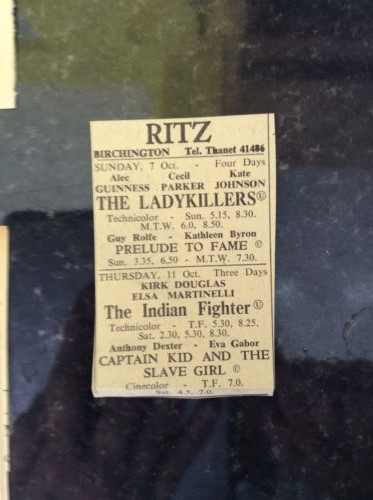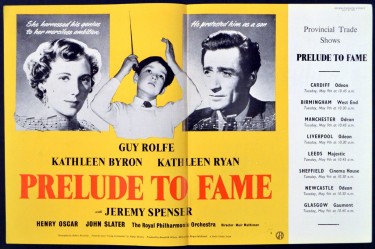Kathleen Byron, who died on January 18 2009 aged 88, was an English actress.
In the British cinema of the Forties, her beauty was faintly disquieting. When Margaret Lockwood played “wicked ladies”, audiences knew where they were. She was a bad lot, and that was it. With Kathleen Byron they never quite knew what to expect. There were hints of schizophrenia in her on-screen personality that left people deeply uneasy.
The film that best reflected this was Black Narcissus (1947), adapted by Michael Powell and Emeric Pressburger from a novel by Rumer Godden which was set in a convent high in the Himalayas. Kathleen Byron played Sister Ruth. This was a terrific role for her. When she was told she had got the part Michael Powell said ‘make the best of it Kathleen because you will never get a part as good again. She later said that she agreed with him and she didn’t think she had ever had a part anywhere as good again.
“Afterwards I received letters from psychiatrists saying it was a marvellous portrayal of someone on the verge of collapse,” she said later. “And I think it was because I kept in my mind all the time that she was sane.”
Above: Avery interesting Cinema Newpaper Advertisement – Surprising to see what choices are made of which films to feature on a Double Bill.
We see Kathleen Byron in ‘Prelude to Fame’ with Guy Rolfe and Jeremy Spenser – who seemed to have a successful career in films and on Television – as a child star – in the early to mid 50s but the sort of fell off the radar. He continued in films up to being nearly 30 years old though – and indeed he made quite a lot of films.
Also we cannot forget that he played alongside Marilyn Monroe and Laurence Olivier in ‘The Prince and the Showgirl’
Looking at the picture above – you would have thought that being in such close proximity to Marilyn, he would look a little happier
Now back to Kathleen Byron – Michael Powell was the director who best understood her talents, and he offered her roles that would tap them. The first was a small part in the whimsical A Matter of Life and Death (1946) as an angel whose job is to take down the particulars of recently dead airmen prior to sending them before the heavenly tribunal.
Her third film with Michael Powell was The Small Back Room. The story of a troubled scientist (David Farrar) who hits the bottle under the pressure of wartime research. Far from being the traditional, subservient “love interest”, her role became the stronger of the two, capable of galvanising Farrar out of his self-absorption. It was not how audiences expected their heroines to behave in 1949.
Powell was one of his actress’s biggest fans. He was captivated by her “luminous eyes” and by her deep voice, “with the hint of mockery in it”. Immodestly, he claimed to recognise in her “an intelligence as cool as my own”. But he couldn’t use her more, because, he said, “the parts were not there; and I’m not in this business to work for women.”
The daughter of a railway clerk who became a Labour mayor of East Ham, Kathleen Elizabeth Byron was born on January 11 1923 and educated at East Ham grammar school. She said she spent her schoolyears “daydreaming of becoming an actress” and obtained a scholarship to the Old Vic. After war service in censorship, she spent some time with the theatre’s company, obtaining her first speaking part in the film The Young Mr Pitt (1942).
In 1943 she married Lieutenant John Bowen, a USAAF pilot, joining him in the States; but her career did not prosper there, and Michael Powell persuaded her to return home.
The late Forties, in which she made the three films with Powell, were the most productive of her career. Afterwards it languished. A second trip to Hollywood in 1953 to play in Young Bess led nowhere.
Her part was overshadowed by Jean Simmons as the young Queen Elizabeth I and by Deborah Kerr as Catherine Parr.
“I went to see John Huston for the role of Lygia in Quo Vadis,” Byron said of her Hollywood years, “I said to him ‘I don’t know how you see me,’ and he replied: ‘We in Hollywood see you as strictly neurotic, Miss Byron.'” She even admitted taking a cynical view of the showbusiness world, saying: “I was no Joan Collins.”
Increasingly, she drifted into second features and supporting parts in bigger pictures. Few were memorable. They ranged from stolid literary adaptations such as Tom Brown’s Schooldays (1951) to such horror pictures as Night of the Eagle (1962) and Craze (1973). When she landed more prestigious roles, they failed to register with audiences. Her Desdemona, for example, was heard rather than seen – on the soundtrack of the dubbed version of a Russian film of 1957.
For a time in the mid-Sixties a car accident, in which she broke her pelvis and some ribs, kept her out of British films. After recovering she was frequently cast in matriarchal roles. She was Robin Hood’s mother in Wolfhead (1969) and the mother of a Polish patriot in From a Far City: Pope John Paul II (1981), both made for television.
There was a cameo role as Lady Waddington in The Elephant Man (1980), the part of Mrs Goddard alongside Gwyneth Paltrow in Emma (1995) and old Mrs Ryan in the Oscar-winning Saving Private Ryan (1998). She found more rewarding work in television, appearing in literary adaptations (Portrait of a Lady and The Golden Bowl) and in long-running soaps such as Emmerdale Farm.
In a series based on the life of King Edward VII, she played Queen Louise of Denmark, mother of Alexandra, the future Queen of England.
Her first marriage was dissolved in 1950. She married, secondly, the radio journalist Alaric Jacob, who predeceased her. A son, a daughter, and a stepdaughter survive her.



“PRELUDE TO FAME”, filmed in 1949 and released in 1950, was a remarkable picture that featured a remarkable performance from the then 12 years old JEREMY SPENSER as the child musical prodigy with the symphonic sequences truly outstanding. In 1949, before a single foot of film was exposed, Jeremy spent many weeks being taught how to conduct an orchestra by Marcus Dods, assistant to Muir Matheison at Rank and came through with flying colours. The result was that the boy’s conducting caught fire on film and looks very real. Like its musical subject, the film starts off slowly and quietly, gradually building to a crescendo. The part was originally offered to Bobby Henrey, but Alexander Korda, who had him under contract, wouldn’t loan him out to Rank. So Jeremy got the part instead.
KATHLEEN BYRON, who seemed to specialise in sexually frustrated roles, gives an excellent performance as the little boy’s embittered, selfish and self centred manager who can’t have children of her own and wants to take him away from his family and friends and keep him all to herself. A situation that almost leads to tragedy for him. She is so possessive of him that in one particular still, the look on her face seems to suggest that she’s lusting after him and wants him body and soul. I have been able to collect quite a number of original press stills for this film, although no Front of House stills have turned up as yet. It’s not available on DVD, but I managed to get a private DVD-R of it off an eBay seller. The film has been shown a number of times of Talking Pictures TV.
She plays the same kind of frustrated role lusting after John Bentley in the 1954 film
Profile.
I am not familiar with that film Robert. I certainly did like her in films. When she go the part of Sister Ruth in ‘Black Narcissus’ Michael Powell said to het ‘make the most of it Kathleen because you’ll never get a part as good as that again’ – and she later said ‘ he was right – I never did’
I just wonder how she would have been as the neurotic Miss Giddens in “THE INNOCENTS” if she’d have got the part instead of Deborah Kerr.
I think that she would have been perfect in that role, David. I have not thought of that before, but now you mention it, she would seem like a perfect choice
Yes Neil. she played that part in Black Narcissus to perfection.
… [Trackback]
[…] Here you will find 43684 more Info on that Topic: filmsofthefifties.com/kathleen-byron-and-jeremy-spenser/ […]
… [Trackback]
[…] Information to that Topic: filmsofthefifties.com/kathleen-byron-and-jeremy-spenser/ […]
… [Trackback]
[…] Here you will find 87083 more Information to that Topic: filmsofthefifties.com/kathleen-byron-and-jeremy-spenser/ […]